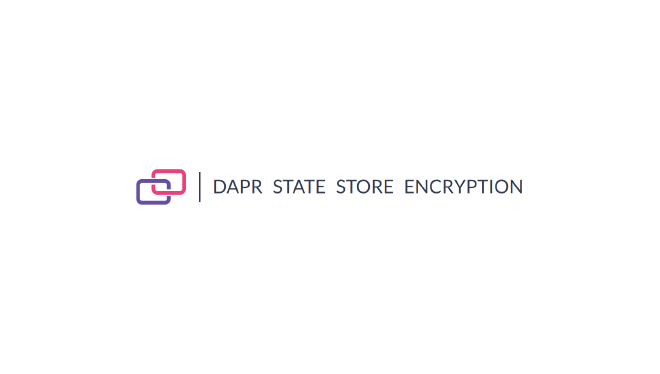Dapr | State Store Encryption

Table of Contents
之前源码系列文章讲到过, Dapr 可以对集群内部提供 kv store (键值存储) 的功能. 但是很多时候我们希望有更好的安全性, 因为存储功能总是需要外部软件提供, 所以 dapr 提供了键值存储自动加密的功能.
注意: 这个功能目前还处于 Preview feature 阶段, 如果要使用需要在全局配置中开启这个特性. 本文源码对应 dapr v1.5.1 版本.
基本思路 #
dapr 选用 AES-256-GCM 对称加密算法进行数据加解密, 因为用户应用都是通过 dapr API 来读取, 新增或者修改数据, 所以 dapr 在写入/修改 handler 中增加加密逻辑, 在读取 handler 中增加解密逻辑就可以实现此功能了.
源码解析 #
此功能使用时需要在 state store component 配置中增加 primaryEncryptionKey 作为秘钥, 如果没有配置则当做不加密处理. 所以在 component 初始化阶段 dapr runtime 会根据配置标记该 store 的加解密配置.
// pkg/runtime/runtime.go
func (a *DaprRuntime) initState(s components_v1alpha1.Component) error {
...
// 检查全局配置是否开启此 feature
if config.IsFeatureEnabled(a.globalConfig.Spec.Features, config.StateEncryption) {
secretStore := a.getSecretStore(secretStoreName)
// 从 component 配置中尝试读取 aes 秘钥
encKeys, encErr := encryption.ComponentEncryptionKey(s, secretStore)
if encErr != nil {
log.Errorf("error initializing state store encryption %s (%s/%s): %s", s.ObjectMeta.Name, s.Spec.Type, s.Spec.Version, encErr)
diag.DefaultMonitoring.ComponentInitFailed(s.Spec.Type, "creation")
return encErr
}
if encKeys.Primary.Key != "" {
// 如果配置了秘钥说明此 store 后续需要加解密, 将秘钥信息保存在全局 map 中
ok := encryption.AddEncryptedStateStore(s.ObjectMeta.Name, encKeys)
if ok {
log.Infof("automatic encryption enabled for state store %s", s.ObjectMeta.Name)
}
}
}
...
}
注意: 由于使用 AES-256-GCM 加密算法, 所以秘钥必须为 32 bytes, 并且需要是 hex 格式.
写入/更新 #
以 HTTP API 为例:
// pkg/http/api.go
func (a *api) onPostState(reqCtx *fasthttp.RequestCtx) {
...
// 上面初始化可以看出配置了秘钥的 store 会被放在全局 map 中
// 下面函数就是去该 map 中查找当前 store 是否配置秘钥
if encryption.EncryptedStateStore(storeName) {
data := []byte(fmt.Sprintf("%v", r.Value))
// 对值进行加密
val, encErr := encryption.TryEncryptValue(storeName, data)
if encErr != nil {
statusCode, errMsg, resp := a.stateErrorResponse(encErr, "ERR_STATE_SAVE")
resp.Message = fmt.Sprintf(messages.ErrStateSave, storeName, errMsg)
respond(reqCtx, withError(statusCode, resp))
log.Debug(resp.Message)
return
}
reqs[i].Value = val
}
...
}
接着查看 encryption.TryEncryptValue 方法:
// pkg/encryption/state.go
func TryEncryptValue(storeName string, value []byte) ([]byte, error) {
keys := encryptedStateStores[storeName]
enc, err := encrypt(value, keys.Primary, AES256Algorithm)
if err != nil {
return value, err
}
sEnc := b64.StdEncoding.EncodeToString(enc) + separator + keys.Primary.Name
return []byte(sEnc), nil
}
可以看到最终存在外部存储中的值为 base64(aes256gcm(data)) + || + primaryEncryptionKey name 的形式.
为什么不直接存储加密后的值而是在后面还拼接了秘钥名称?
因为此功能提供了一个 Key rotation 的功能, 也就是为了方便用户修改秘钥. 所以加密功能其实是可以配置 primaryEncryptionKey 和 secondaryEncryptionKey 两个秘钥, 更新秘钥时, 需要将老的秘钥配置为 secondaryEncryptionKey. 加密永远会使用 primaryEncryptionKey, 新增数据会直接使用新秘钥, 而老数据只有在更新时才会用新秘钥加密. 因此存储中会同时存在新老秘钥加密的数据, 为了能够正常解密, dapr 才将加密使用秘钥名称存储在了每条数据中.
读取 #
以 HTTP API 为例, 读取实现非常简单, 如果发现请求的 store 配置了加密功能, 增加一步解密操作.
// pkg/http/api.go
func (a *api) onGetState(reqCtx *fasthttp.RequestCtx) {
...
// 同写入操作
if encryption.EncryptedStateStore(storeName) {
// 尝试解密
val, err := encryption.TryDecryptValue(storeName, resp.Data)
if err != nil {
msg := NewErrorResponse("ERR_STATE_GET", fmt.Sprintf(messages.ErrStateGet, key, storeName, err.Error()))
respond(reqCtx, withError(fasthttp.StatusInternalServerError, msg))
log.Debug(msg)
return
}
resp.Data = val
}
...
}
接着查看 encryption.TryDecryptValue 方法:
// pkg/encryption/state.go
func TryDecryptValue(storeName string, value []byte) ([]byte, error) {
keys := encryptedStateStores[storeName]
// 将拿到数据使用 || 分割, 获取对应的秘钥名称
ind := bytes.LastIndex(value, []byte(separator))
keyName := string(value[ind+len(separator):])
if len(keyName) == 0 {
return value, errors.Errorf("could not decrypt data for state store %s: encryption key name not found on record", storeName)
}
var key Key
// 从 primaryEncryptionKey 和 secondaryEncryptionKey 中找到名称匹配的秘钥
if keys.Primary.Name == keyName {
key = keys.Primary
} else if keys.Secondary.Name == keyName {
key = keys.Secondary
}
return decrypt(value[:ind], key, AES256Algorithm)
}
总结 #
这个新特性实现是非常简单的, 但是 primaryEncryptionKey 和 secondaryEncryptionKey 的设计减轻了更换秘钥的难度值得学习.
参考资料 #
